Food Emotional Perception and Eating Willingness Under Different Lighting Colors: A Preliminary Study Based on Consumer Facial Expression Analysis
Abstract
1. Introduction
- Adjusting consumer preferences through lighting color can potentially influence consumers’ eating behavior and food choices.
- By controlling the changes in light color, participants experienced significant emotional fluctuations towards food under different lighting environments.
- In the context of food consumption, consumers’ facial expressions can reflect their emotional state type and intensity of emotional fluctuations towards food, and are positively correlated with the results of subjective preference surveys.
2. Materials and Methods
2.1. Experimental Setup
2.2. Experimental Procedure
2.2.1. Measurement with GFER
2.2.2. Stimuli and Presentation
2.2.3. Experimental Implementation
2.2.4. Data Processing and Analysis
3. Results
3.1. Preliminary Response Data from GFER
3.2. Lighting Color and Emotional States
3.2.1. Group Analysis of Lighting Color Effects on Emotional States
3.2.2. Subjective Preferences: Eating Willingness and Liking
3.2.3. Correlation Between Facial Expression Recognition and Subjective Ratings
3.3. Variability of Emotional States and Eating Willingness the Experiment Identified Consumer
3.4. Influence of Lighting on Eating Willingness
4. Discussion
4.1. Correlation Between Facial Emotional Responses and Subjective Preferences
4.2. Cross-Validation of Facial Recognition and Subjective Ratings
4.3. Limitations of Facial Expression Recognition Technology and Subjective Preference Rating Validation
5. Conclusions
Author Contributions
Funding
Institutional Review Board Statement
Informed Consent Statement
Data Availability Statement
Acknowledgments
Conflicts of Interest
Appendix A
Appendix A.1
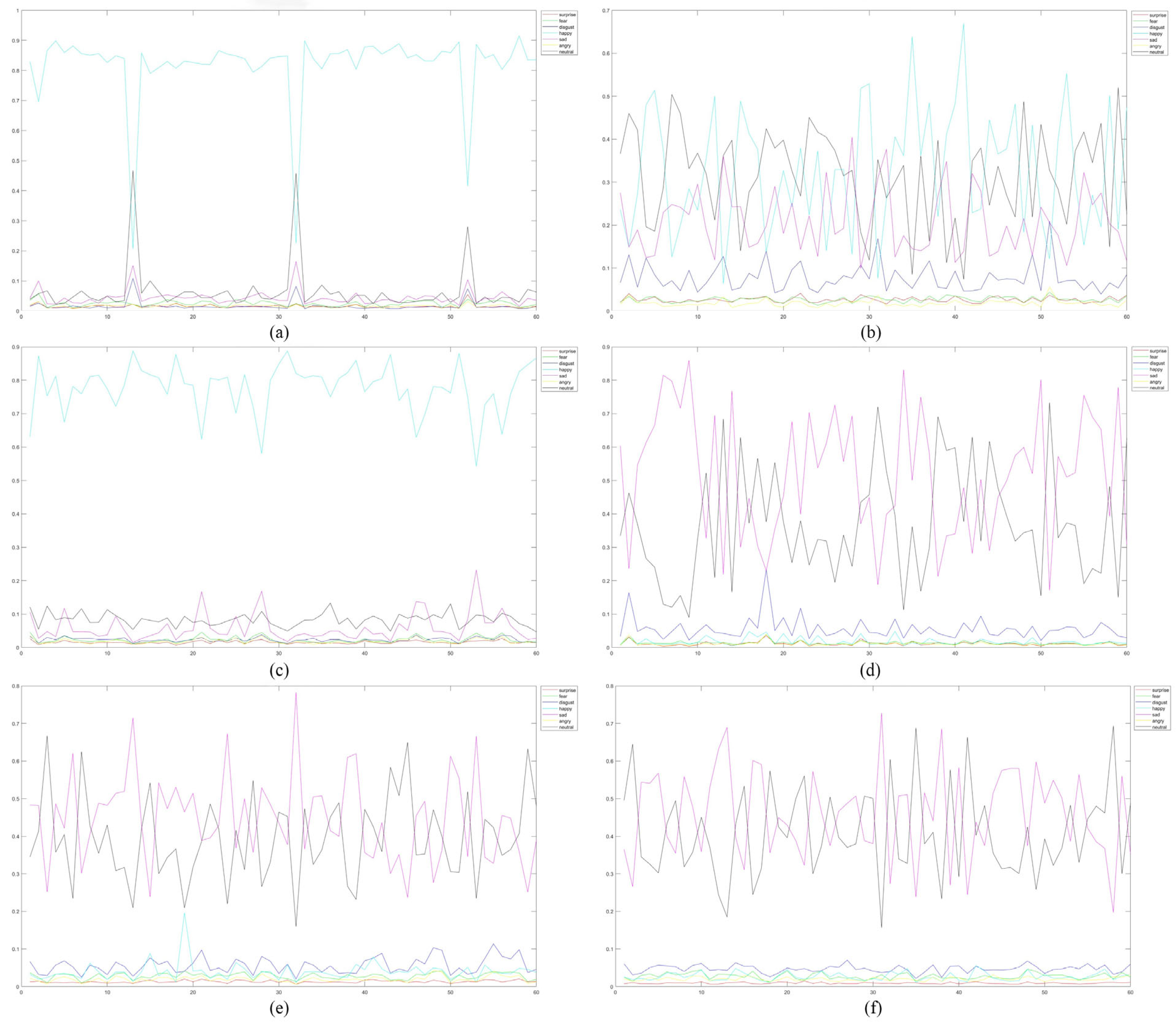
Appendix A.2
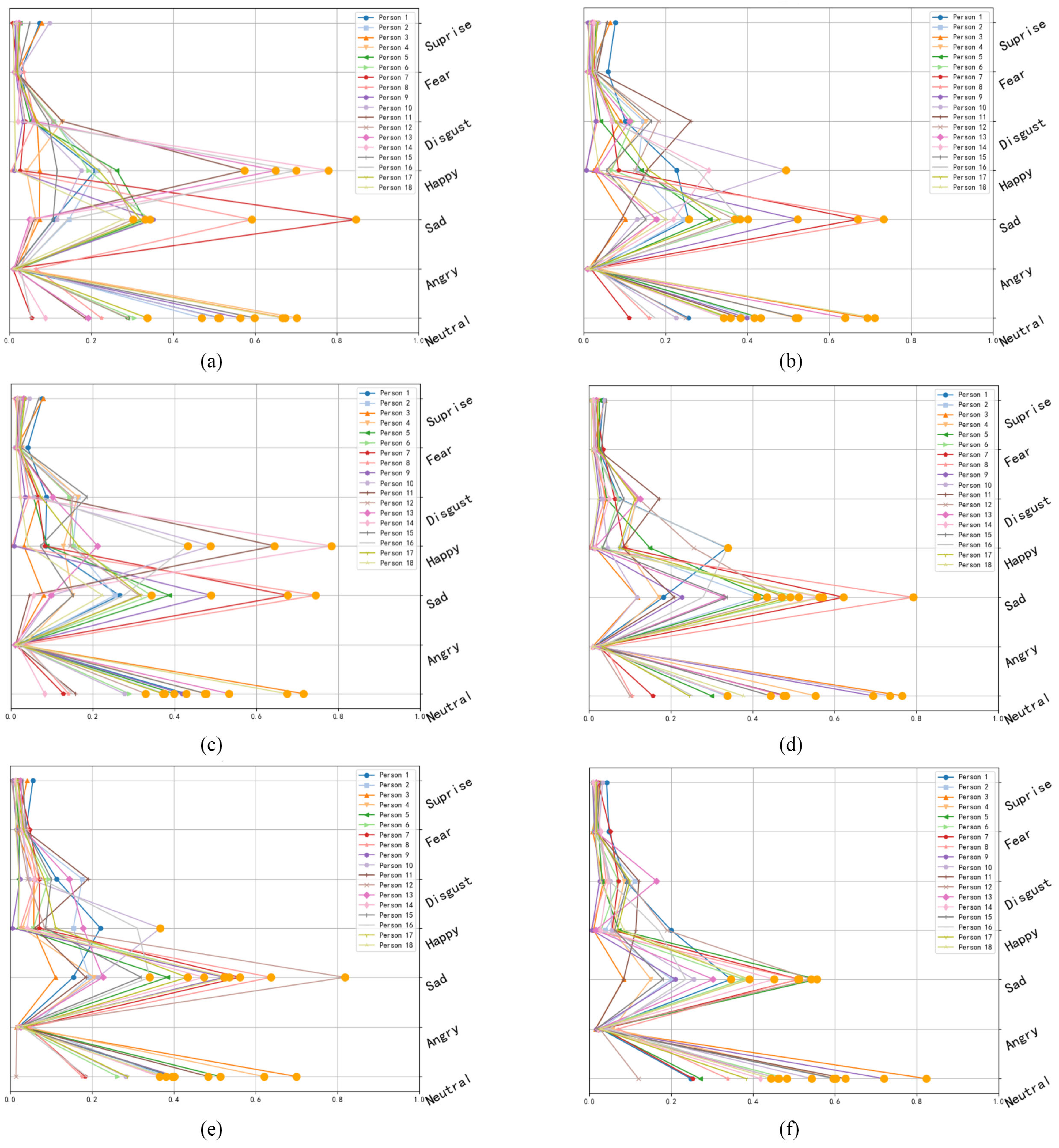
References
- Genschow, O.; Reutner, L.; Wänke, M. The color red reduces snack food and soft drink intake. Appetite 2012, 58, 699–702. [Google Scholar] [CrossRef]
- Spence, C.; Levitan, C.A. Explaining crossmodal correspondences between colours and tastes. i-Perception 2021, 12, 20416695211018223. [Google Scholar] [CrossRef] [PubMed]
- Woods, A.T.; Spence, C. Using single colors and color pairs to communicate basic tastes. i-Perception 2016, 7, 2041669516658817. [Google Scholar] [CrossRef] [PubMed]
- Huang, Y.-T.; Lee, W.-T. Effects of Different Candies and Color Variations in Mukbang ASMR on Visual Attention and Emotion. In Proceedings of the IEEE 2023 International Conference on Consumer Electronics-Taiwan (ICCE-Taiwan), Pingtung, Taiwan, 17–19 July 2023. [Google Scholar]
- Tu, Y.J.; Yang, Z. A Review and Implications of the Impact of Packaging on Food Taste Experience. Packag. Eng. 2013, 34, 68–72. [Google Scholar]
- Lee, S.M.; Lee, K.T.; Lee, S.H.; Song, J.K. Origin of human colour preference for food. J. Food Eng. 2013, 119, 508–515. [Google Scholar] [CrossRef]
- Wang, C.Y. The enhancement of appetite through the use of colored light in case of a cake: Preliminary evidence from event-related potentials. Color Res. Appl. 2021, 46, 456–466. [Google Scholar] [CrossRef]
- Delwiche, J. The impact of perceptual interactions on perceived flavor. Food Qual. Prefer. 2004, 15, 137–146. [Google Scholar] [CrossRef]
- Spence, C.; Levitan, C.A.; Shankar, M.U.; Zampini, M. Does Food Color Influence Taste and Flavor Perception in Humans? Chemosens. Percept. 2010, 3, 68–84. [Google Scholar] [CrossRef]
- Spence, C. On the relationship(s) between color and taste/flavor. Exp. Psychol. 2019, 66, 99–111. [Google Scholar] [CrossRef]
- Tešić, D.; Bogetić, Z.; Petković, G. The influence of retail facility lighting on shoppers’ product perception. Strateg. Manag. 2022, 27, 41–54. [Google Scholar] [CrossRef]
- Maughan, C.; Chambers IV, E.; Godwin, S. A procedure for validating the use of photographs as surrogates for samples in sensory measurement of appearance: An example with color of cooked turkey patties. J. Sens. Stud. 2016, 31, 507–513. [Google Scholar] [CrossRef]
- Biswas, D.; Szocs, C.; Chacko, R.; Wansink, B. Shining Light on Atmospherics: How Ambient Light Influences Food Choices. J. Mark. Res. 2017, 54, 111–123. [Google Scholar] [CrossRef]
- Yang, F.L.; Cho, S.; Seo, H.S. Effects of Light Color on Consumers’ Acceptability and Willingness to Eat Apples and Bell Peppers. J. Sens. Stud. 2016, 31, 3–11. [Google Scholar] [CrossRef]
- Spence, C. On the psychological impact of food colour. Flavour 2015, 4, 21. [Google Scholar] [CrossRef]
- Barbut, S. Effect of illumination source on the appearance of fresh meat cuts. Meat Sci. 2001, 59, 187–191. [Google Scholar] [CrossRef] [PubMed]
- Maughan, C.; Iv, E.C.; Godwin, S.; Chambers, D. Changes in lighting source can produce inaccurate assessment of visual poultry doneness and induce consumers to eat undercooked ground turkey patties. J. Food Prot. 2019, 82, 528–534. [Google Scholar] [CrossRef] [PubMed]
- Horská, E.; Berčík, J. The influence of light on consumer behavior at the food market. J. Food Prod. Mark. 2014, 20, 429–440. [Google Scholar] [CrossRef]
- Hasenbeck, A.; Cho, S.; Meullenet, J.F.; Tokar, T.; Yang, F.; Huddleston, E.A.; Seo, H.S. Color and illuminance level of lighting can modulate willingness to eat bell peppers. J. Sci. Food Agric. 2014, 94, 2049–2056. [Google Scholar] [CrossRef]
- Xie, X.; Cai, J.; Fang, H.; Tang, X.; Yamanaka, T. Effects of colored lights on an individual’s affective impressions in the observation process. Front. Psychol. 2022, 13, 938636. [Google Scholar] [CrossRef]
- Feng, J.; Huang, F.J.; Dong, J.H.; Han, Y.; Liu, R.; Wang, C.; Song, T.; Wang, L.H.; Zhang, J.J.; Han, X.L.; et al. A Preliminary Study on the Sensory and Consumer Acceptance Evaluation of Fortified Wine by Facial Expression Analysis Technology. Food Ferment. Ind. 2022, 48, 257–262. [Google Scholar]
- Zhen, S.H.; Liu, Q.; Luo, R.; Tian, S.Y.; Shen, S.; Ren, Y.J. Analysis Dataset of Food Consumption Behavior Based on Eye Movement Tracking: Taking Functional Foods as an Example. J. Agric. Big Data 2023, 5, 103–109. [Google Scholar]
- Jantathai, S.; Danner, L.; Joechl, M.; Dürrschmid, K. Gazing behavior, choice and color of food: Does gazing behavior predict choice? Food Res. Int. 2013, 54, 1621–1626. [Google Scholar] [CrossRef]
- Wang, J.; Fang, X. Research on Visual Experience of Food Design Based on Eye-Tracking Technology. Packag. Eng. 2020, 41, 169–173. [Google Scholar]
- de Wijk, R.A.; Noldus, L.P. Using implicit rather than explicit measures of emotions. Food Qual. Prefer. 2021, 92, 104125. [Google Scholar] [CrossRef]
- De Wijk, R.A.; Kaneko, D.; Dijksterhuis, G.B.; van Zoggel, M.; Schiona, I.; Visalli, M.; Zandstra, E.H. Food perception and emotion measured over time in-lab and in-home. Food Qual. Prefer. 2019, 75, 170–178. [Google Scholar] [CrossRef]
- Zhi, R.; Wan, J.; Zhang, D.; Li, W. Correlation between hedonic liking and facial expression measurement using dynamic affective response representation. Food Res. Int. 2018, 108, 237–245. [Google Scholar] [CrossRef] [PubMed]
- Kostyra, E.; Rambuszek, M.; Waszkiewicz-Robak, B.; Laskowski, W.; Blicharski, T.; Poławska, E. Consumer facial expression in relation to smoked ham with the use of face reading technology. The methodological aspects and informative value of research results. Meat Sci. 2016, 119, 22–31. [Google Scholar] [CrossRef]
- Matsufuji, Y.; Ueji, K.; Yamamoto, T. Predicting Perceived Hedonic Ratings through Facial Expressions of Different Drinks. Foods 2023, 12, 3490. [Google Scholar] [CrossRef]
- Gupta, M.; Torrico, D.D.; Hepworth, G.; Gras, S.L.; Ong, L.; Cottrell, J.J.; Dunshea, F.R. Differences in Hedonic Responses, Facial Expressions and Self-Reported Emotions of Consumers Using Commercial Yogurts: A Cross-Cultural Study. Foods 2021, 10, 1237. [Google Scholar] [CrossRef]
- Byeon, J.; Chung, H. An Analysis of Emotional Changes in Facial Expressions of Mukbang YouTubers Using FaceReader Program. Culin. Sci. Hosp. Res. 2023, 29, 94–107. [Google Scholar] [CrossRef]
- Bartkiene, E.; Steibliene, V.; Adomaitiene, V.; Juodeikiene, G.; Cernauskas, D.; Lele, V.; Klupsaite, D.; Zadeike, D.; Jarutiene, L.; Guiné, R. Factors Affecting Consumer Food Preferences: Food Taste and Depression-Based Evoked Emotional Expressions with the Use of Face Reading Technology. Biomed. Res. Int. 2019, 2019, 2097415. [Google Scholar] [CrossRef]
- Barrett, L.F.; Mesquita, B.; Ochsner, K.N.; Gross, J.J. The experience of emotion. Annu. Rev. Psychol. 2007, 58, 373–403. [Google Scholar] [CrossRef] [PubMed]
- Bhati, V.S.; Tiwari, N.; Chawla, M. A Generalized Zero-Shot Deep Learning Classifier for Emotion Recognition Using Facial Expression Images. IEEE Access 2025, 13, 18687–18700. [Google Scholar] [CrossRef]
- Ye, J.; Liu, D.; Wang, C.; Huang, H.; Ying, L.; Zhang, L.; Jiang, A. CNLA: Collaborative Noisy Label Adaptive Learning for Facial Expression Recognition. Inf. Sci. 2025, 719, 122436. [Google Scholar] [CrossRef]
- Zhang, Y.; Zheng, X.; Liang, C.; Hu, J.; Deng, W. Generalizable Facial Expression Recognition. In Proceedings of the European Conference on Computer Vision, Milan, Italy, 29 September–4 October 2024. [Google Scholar]
- Danner, L.; Sidorkina, L.; Joechl, M.; Duerrschmid, K. Make a face! Implicit and explicit measurement of facial expressions elicited by orange juices using face reading technology. Food Qual. Prefer. 2014, 32, 167–172. [Google Scholar] [CrossRef]
- Fang, Z.; Yingchen, Z.; Jiaoliang, H.; Feifei, Z.; Yixun, X. Interaction between Overall Liking and Concurrent Quantification of Hedonic Sensory Characteristics. J. Chin. Inst. Food Sci. Technol. 2024, 24, 12–23. [Google Scholar]
- van Bommel, R.; Stieger, M.; Visalli, M.; de Wijk, R.; Jager, G. Does the face show what the mind tells? A comparison between dynamic emotions obtained from facial expressions and Temporal Dominance of Emotions (TDE). Food Qual. Prefer. 2020, 85, 103976. [Google Scholar] [CrossRef]
- Rocha, C.; Lima, R.C.; Moura, A.P.D.; Costa, T.; Cunha, L.M. Implicit evaluation of the emotional response to premium organic herbal infusions through a temporal dominance approach: Development of the temporal dominance of facial emotions (TDFE). Food Qual. Prefer. 2019, 76, 71–80. [Google Scholar] [CrossRef]
- Beyts, C.; Chaya, C.; Dehrmann, F.; James, S.; Smart, K.; Hort, J. A comparison of self-reported emotional and implicit responses to aromas in beer. Food Qual. Prefer. 2017, 59, 68–80. [Google Scholar] [CrossRef]
- Yu, C.Y.; Ko, C.H. Applying FaceReader to Recognize Consumer Emotions in Graphic Styles. In Proceedings of the 27th CIRP Design Conference, Grenoble, France, 13–15 May 2017. [Google Scholar]
- De Wijk, R.A.; Kaneko, D.; Dijksterhuis, G.B.; van Bergen, G.; Vingerhoeds, M.H.; Visalli, M.; Zandstra, E.H. A preliminary investigation on the effect of immersive consumption contexts on food-evoked emotions using facial expressions and subjective ratings. Food Qual. Prefer. 2022, 99, 104572. [Google Scholar] [CrossRef]
- Huang, W.; Zhang, S.; Zhang, P.; Zha, Y.; Fang, Y.; Zhang, Y. Identity-Aware Facial Expression Recognition Method Based on Synthesized Images and Deep Metric Learning. J. Comput.-Aided Des. Comput. Graph. 2021, 33, 724–732. [Google Scholar] [CrossRef]
- Tzafilkou, K.; Panavou, F.R.; Economides, A.A. Facially Expressed Emotions and Hedonic Liking on Social Media Food Marketing Campaigns:Comparing Different Types of Products and Media Posts. In Proceedings of the 17th International Workshop on Semantic and Social Media Adaptation and Personalization (SMAP), Corfu, Greece, 3–4 November 2022. [Google Scholar]
- Wendin, K.; Allesen-Holm, B.H.; Bredie, W.L. Do facial reactions add new dimensions to measuring sensory responses to basic tastes? Food Qual. Prefer. 2011, 22, 346–354. [Google Scholar] [CrossRef]
- Marques, C.; Vilela, A. FaceReader Insights into the Emotional Response of Douro Wines. Appl. Sci. 2024, 14, 10053. [Google Scholar] [CrossRef]
- Lee, H.; Lee, E. Effects of coloured lighting on pleasure and arousal in relation to cultural differences. Light. Res. Technol. 2022, 54, 145–162. [Google Scholar] [CrossRef]
- Ucuk, C.; Percin, N.S.; Cevik, C.; Al, T.; Kara, I. Can the image of food mislead the brain? Neurogastronomy research with EEG and emotion recognition. Int. J. Gastron. Food Sci. 2025, 39, 101097. [Google Scholar] [CrossRef]
- Oliver, G.; Wardle, J.; Gibson, E.L. Stress and food choice: A laboratory study. Psychosom. Med. 2000, 62, 853–865. [Google Scholar] [CrossRef]
- Rini, L.; Lagast, S.; Schouteten, J.J.; Gellynck, X.; De Steur, H. Impact of emotional state on consumers’ emotional conceptualizations of dark chocolate using an emoji-based questionnaire. Food Qual. Prefer. 2022, 99, 104547. [Google Scholar] [CrossRef]
- Schlintl, C.; Schienle, A. Effects of Coloring Food Images on the Propensity to Eat: A Placebo Approach with Color Suggestions. Front. Psychol. 2020, 11, 589826. [Google Scholar] [CrossRef]
- Danner, L.; Ristic, R.; Johnson, T.E.; Meiselman, H.L.; Hoek, A.C.; Jeffery, D.W.; Bastian, S.E. Context and wine quality effects on consumers’ mood, emotions, liking and willingness to pay for Australian Shiraz wines. Food Res. Int. 2016, 89, 254–265. [Google Scholar] [CrossRef]
- Ismael, D.; Ploeger, A. Consumers’ Emotion Attitudes towards Organic and Conventional Food: A Comparison Study of Emotional Profiling and Self-Reported Method. Foods 2020, 9, 79. [Google Scholar] [CrossRef]
- Tahir, Y.; Rahman, A.U.; Ravana, S.D. An affect-based classification of emotions associated with images of food. J. Food Meas. Charact. 2021, 15, 519–530. [Google Scholar] [CrossRef]
- Liao, L.X.; Corsi, A.M.; Chrysochou, P.; Lockshin, L. Emotional responses towards food packaging: A joint application of self-report and physiological measures of emotion. Food Qual. Prefer. 2015, 42, 48–55. [Google Scholar] [CrossRef]
- Saito, A.; Sato, W.; Ikegami, A.; Ishihara, S.; Nakauma, M.; Funami, T.; Fushiki, T.; Yoshikawa, S. Subjective-Physiological Coherence during Food Consumption in Older Adults. Nutrients 2022, 14, 4736. [Google Scholar] [CrossRef]
- Cardello, A.V.; Meiselman, H.L.; Schutz, H.G.; Craig, C.; Given, Z.; Lesher, L.L.; Eicher, S. Measuring emotional responses to foods and food names using questionnaires. Food Qual. Prefer. 2012, 24, 243–250. [Google Scholar] [CrossRef]
- Rohr, M.; Kamm, F.; Koenigstorfer, J.; Groeppel-Klein, A.; Wentura, D. The Color Red Supports Avoidance Reactions to Unhealthy Food. Exp. Psychol. 2015, 62, 335–345. [Google Scholar] [CrossRef]
- Macht, M. How emotions affect eating: A five-way model. Appetite 2008, 50, 1–11. [Google Scholar] [CrossRef] [PubMed]
- Desmet, P.M.; Schifferstein, H.N. Sources of positive and negative emotions in food experience. Appetite 2008, 50, 290–301. [Google Scholar] [CrossRef] [PubMed]
- Kenney, E.; Adhikari, K. Recent developments in identifying andquantifying emotions during food consumption. J. Sci. Food Agric. 2016, 96, 3627–3630. [Google Scholar] [CrossRef] [PubMed]
- Hepworth, R.; Mogg, K.; Brignell, C.; Bradley, B.P. Negative mood increases selective attention to food cues and subjective appetite. Appetite 2010, 54, 134–142. [Google Scholar] [CrossRef]
- Sato, W.; Minemoto, K.; Ikegami, A.; Nakauma, M.; Funami, T.; Fushiki, T. Facial EMG Correlates of Subjective Hedonic Responses During Food Consumption. Nutrients 2020, 12, 1174. [Google Scholar] [CrossRef]
- Berčík, J.; Horská, E.; Wang, R.W.; Chen, Y.C. The impact of parameters of store illumination on food shopper response. Appetite 2016, 106, 101–109. [Google Scholar] [CrossRef]
- Takahashi, A.; Yamada, T.; Kobayashi, T.; Kumakura, K.; Matsuoka, H. Effects of fluorescent and LED irradiation on color fading and pale coloration of salted radish root (takuan-zuke). Food Sci. Technol. Res. 2022, 28, 179–185. [Google Scholar] [CrossRef]
- Hong, J.I.; Park, Y.K.; Park, S.H. A Study on the Appropriate Visual Color of RGB LED Lighting—Focusing on Beef Color. J. Korea Soc. Color Stud. 2009, 23, 55–65. [Google Scholar]
- Mehta, A.; Sharma, C.; Kanala, M.; Thakur, M.; Harrison, R.; Torrico, D.D. Self-Reported Emotions and Facial Expressions on Consumer Acceptability: A Study Using Energy Drinks. Foods 2021, 10, 330. [Google Scholar] [CrossRef]
- Xie, X.; Cai, J.; Fang, H.; Wang, B.; He, H.; Zhou, Y.; Xiao, Y.; Yamanaka, T.; Li, X. Affective Impressions Recognition under Different Colored Lights Based on Physiological Signals and Subjective Evaluation Method. Sensors 2023, 23, 5322. [Google Scholar] [CrossRef]
- Zhi, R.; Cao, L.; Cao, G. Asians’ Facial Responsiveness to Basic Tastes by Automated Facial Expression Analysis System. J. Food Sci. 2017, 82, 794–806. [Google Scholar] [CrossRef]
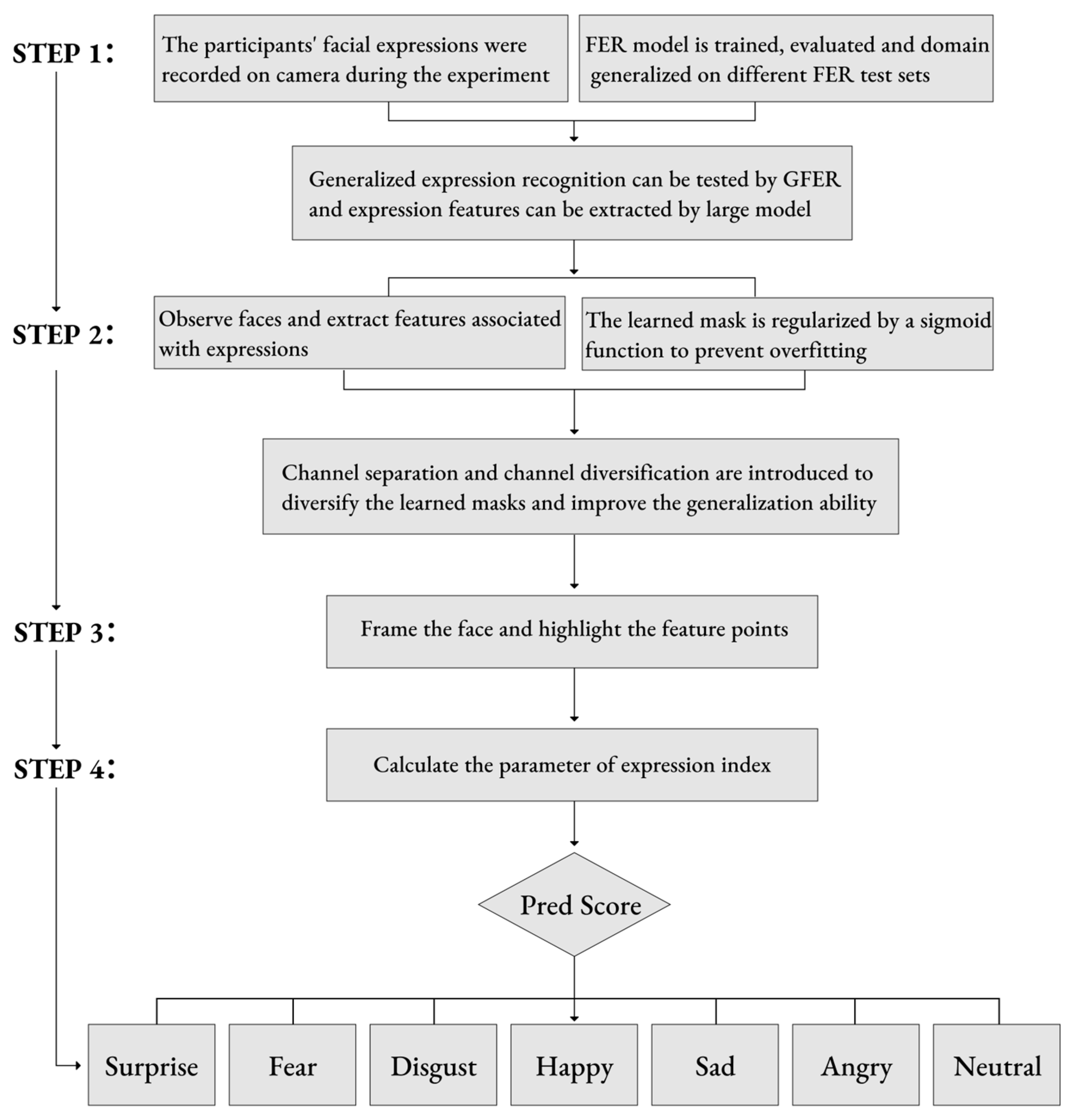
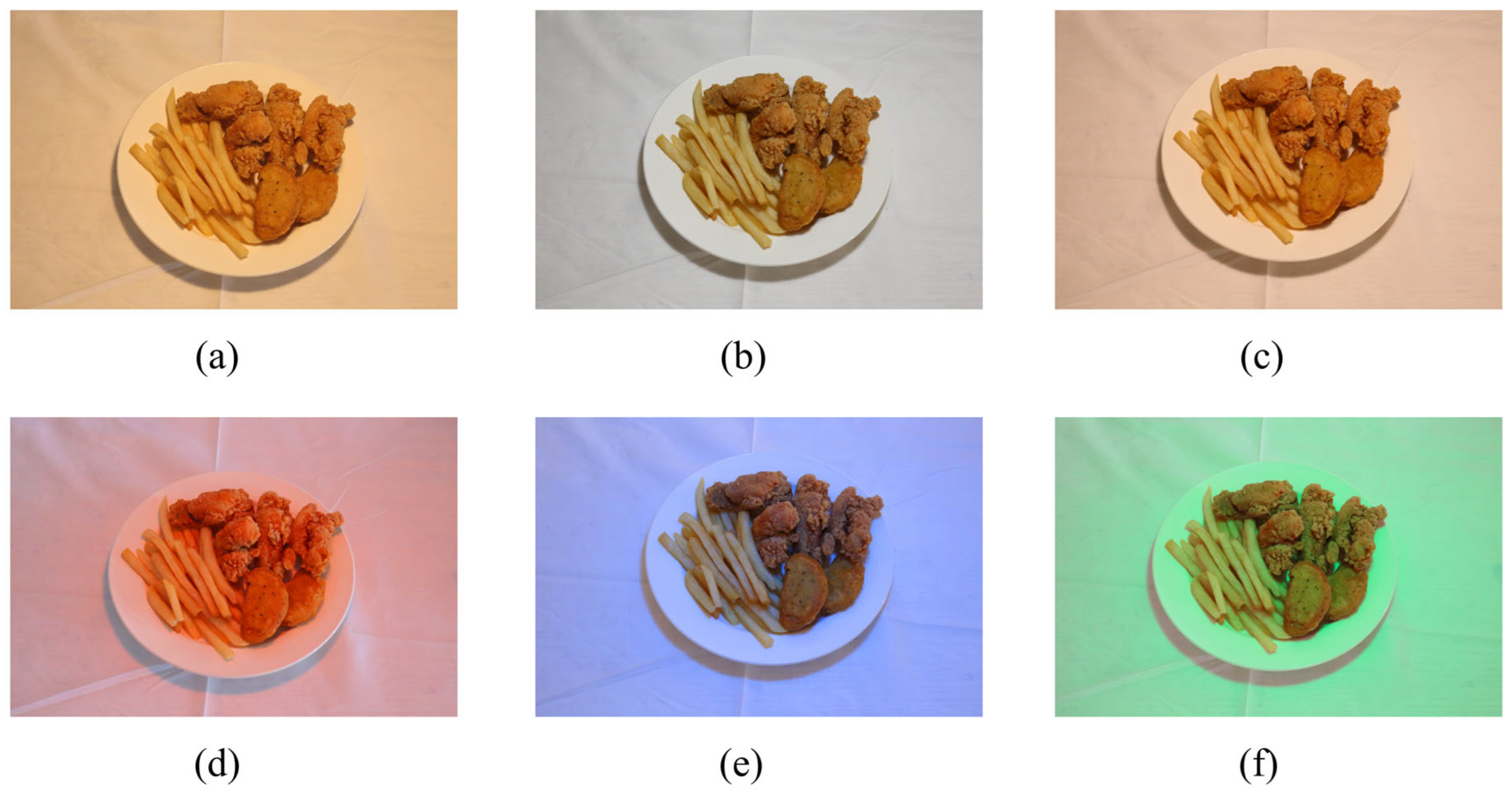
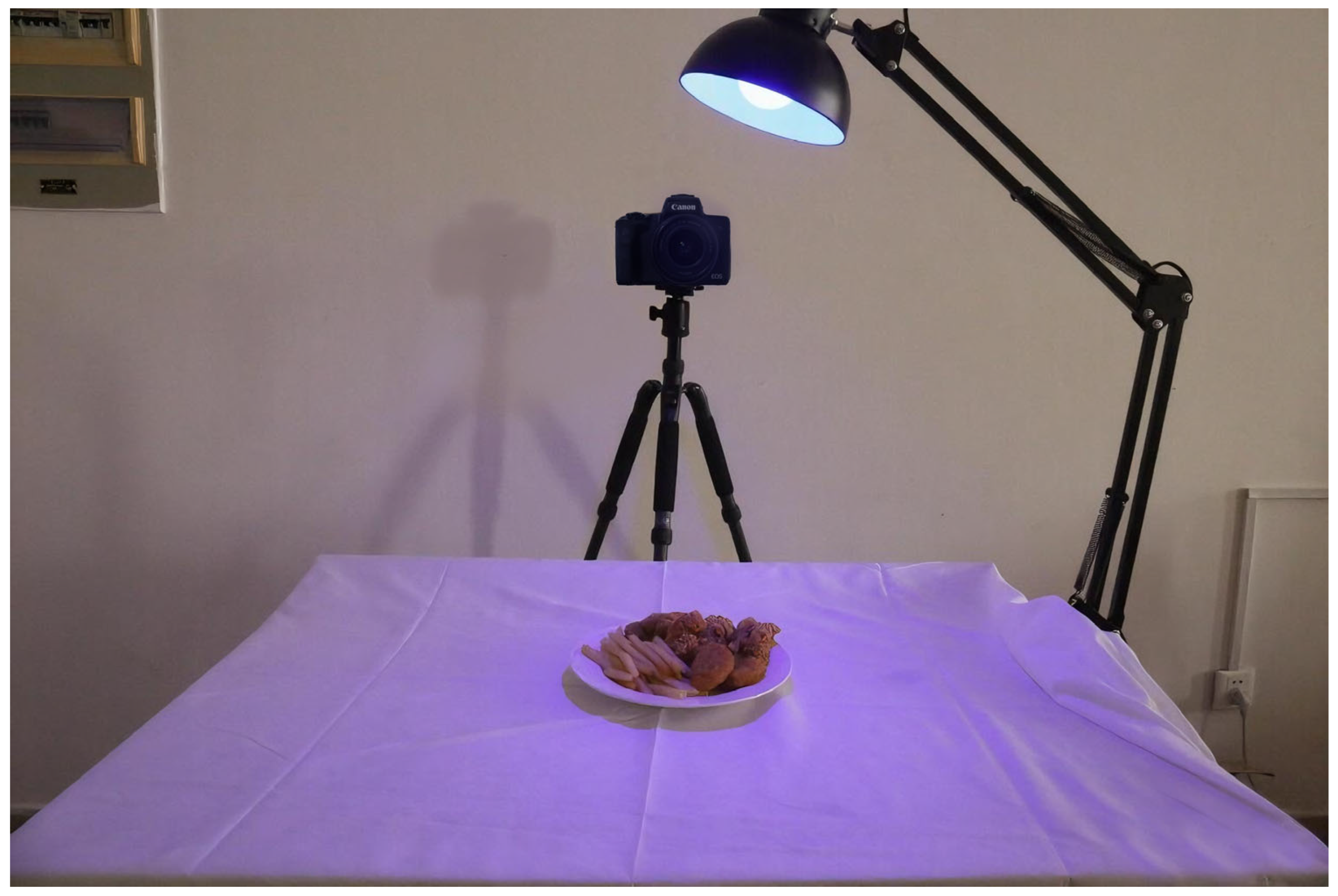



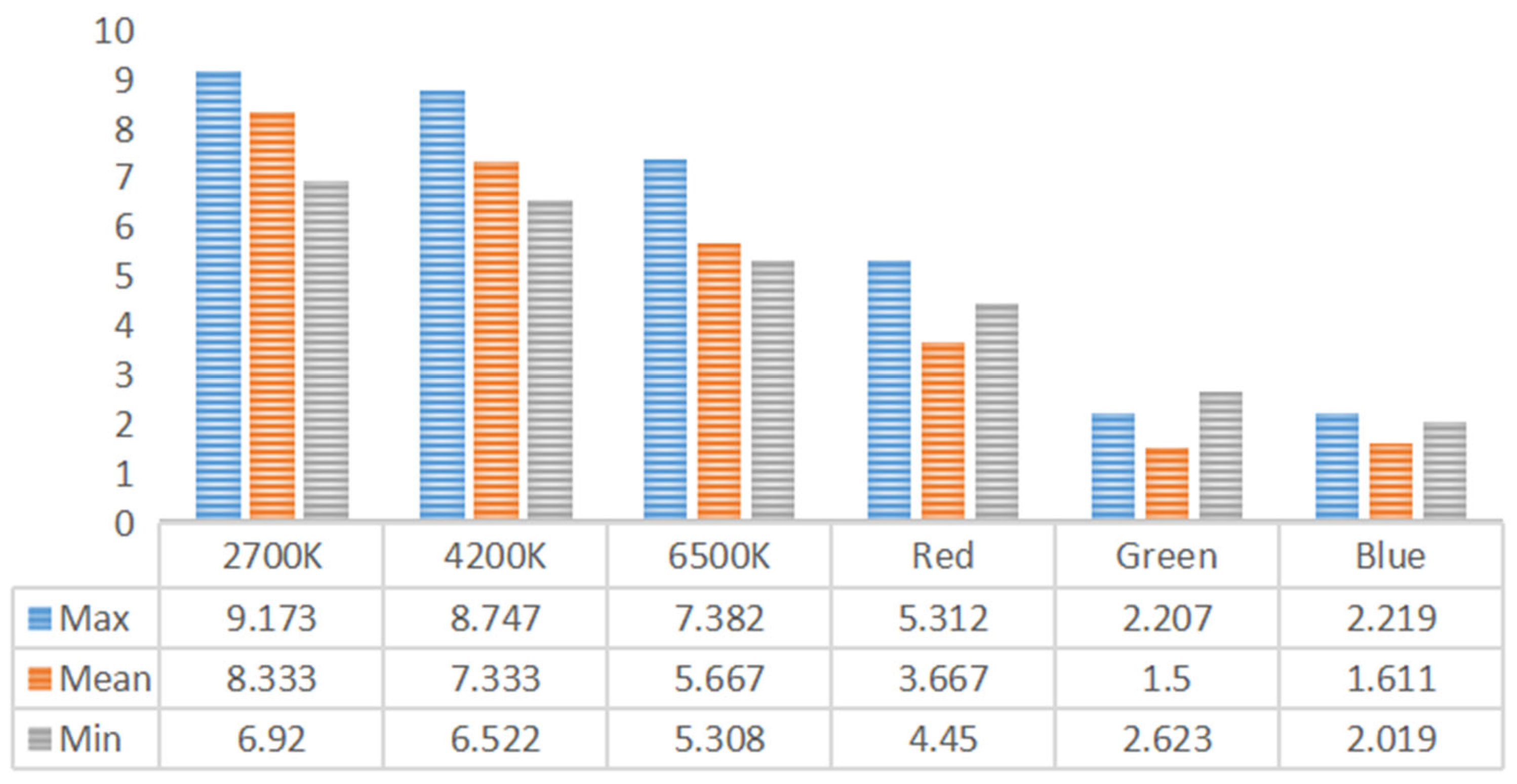
Disclaimer/Publisher’s Note: The statements, opinions and data contained in all publications are solely those of the individual author(s) and contributor(s) and not of MDPI and/or the editor(s). MDPI and/or the editor(s) disclaim responsibility for any injury to people or property resulting from any ideas, methods, instructions or products referred to in the content. |
© 2025 by the authors. Licensee MDPI, Basel, Switzerland. This article is an open access article distributed under the terms and conditions of the Creative Commons Attribution (CC BY) license (https://creativecommons.org/licenses/by/4.0/).
Share and Cite
Shu, Y.; Gao, H.; Wang, Y.; Wei, Y. Food Emotional Perception and Eating Willingness Under Different Lighting Colors: A Preliminary Study Based on Consumer Facial Expression Analysis. Foods 2025, 14, 3440. https://doi.org/10.3390/foods14193440
Shu Y, Gao H, Wang Y, Wei Y. Food Emotional Perception and Eating Willingness Under Different Lighting Colors: A Preliminary Study Based on Consumer Facial Expression Analysis. Foods. 2025; 14(19):3440. https://doi.org/10.3390/foods14193440
Chicago/Turabian StyleShu, Yuan, Huixian Gao, Yihan Wang, and Yangyang Wei. 2025. "Food Emotional Perception and Eating Willingness Under Different Lighting Colors: A Preliminary Study Based on Consumer Facial Expression Analysis" Foods 14, no. 19: 3440. https://doi.org/10.3390/foods14193440
APA StyleShu, Y., Gao, H., Wang, Y., & Wei, Y. (2025). Food Emotional Perception and Eating Willingness Under Different Lighting Colors: A Preliminary Study Based on Consumer Facial Expression Analysis. Foods, 14(19), 3440. https://doi.org/10.3390/foods14193440







